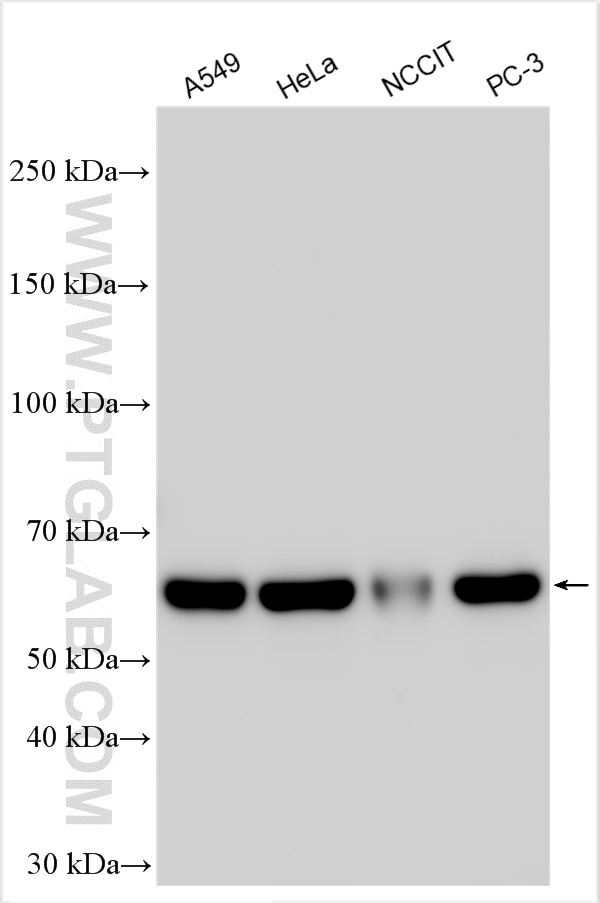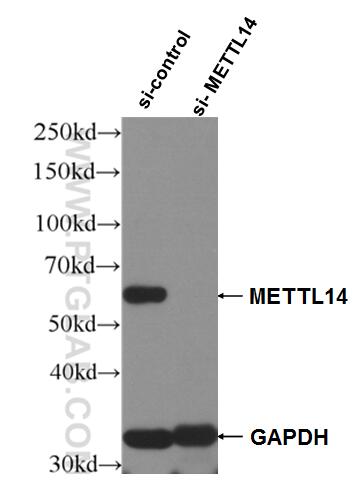- Featured Product
- KD/KO Validated
METTL14 Polyklonaler Antikörper
METTL14 Polyklonal Antikörper für WB, ELISA
Wirt / Isotyp
Kaninchen / IgG
Getestete Reaktivität
human und mehr (2)
Anwendung
WB, RIP, IP, IHC, IF, ELISA
Konjugation
Unkonjugiert
Kat-Nr. : 26158-1-AP
Synonyme
Galerie der Validierungsdaten
Geprüfte Anwendungen
| Erfolgreiche Detektion in WB | A549-Zellen, HeLa-Zellen, NCCIT-Zellen, PC-3-Zellen |
Empfohlene Verdünnung
| Anwendung | Verdünnung |
|---|---|
| Western Blot (WB) | WB : 1:2000-1:10000 |
| It is recommended that this reagent should be titrated in each testing system to obtain optimal results. | |
| Sample-dependent, check data in validation data gallery | |
Veröffentlichte Anwendungen
| KD/KO | See 23 publications below |
| WB | See 73 publications below |
| IHC | See 13 publications below |
| IF | See 10 publications below |
| IP | See 1 publications below |
| RIP | See 6 publications below |
Produktinformation
26158-1-AP bindet in WB, RIP, IP, IHC, IF, ELISA METTL14 und zeigt Reaktivität mit human
| Getestete Reaktivität | human |
| In Publikationen genannte Reaktivität | human, Affe, Huhn |
| Wirt / Isotyp | Kaninchen / IgG |
| Klonalität | Polyklonal |
| Typ | Antikörper |
| Immunogen | METTL14 fusion protein Ag14325 |
| Vollständiger Name | methyltransferase like 14 |
| Berechnetes Molekulargewicht | 456 aa, 52 kDa |
| Beobachtetes Molekulargewicht | 55-60 kDa |
| GenBank-Zugangsnummer | BC007449 |
| Gene symbol | METTL14 |
| Gene ID (NCBI) | 57721 |
| Konjugation | Unkonjugiert |
| Form | Liquid |
| Reinigungsmethode | Protein-A-Reinigung |
| Lagerungspuffer | PBS mit 0.02% Natriumazid und 50% Glycerin pH 7.3. |
| Lagerungsbedingungen | Bei -20°C lagern. Nach dem Versand ein Jahr lang stabil Aliquotieren ist bei -20oC Lagerung nicht notwendig. 20ul Größen enthalten 0,1% BSA. |
Hintergrundinformationen
METTL14, is also named as Methyltransferase-like protein 14 or KIAA1627, is a 456 amino acid protein, which belongs to the MT-A70-like family and localized in the nucleus. The METTL3-METTL14 heterodimer forms a N6-methyltransferase complex that methylates adenosine residues of some mRNAs and regulates the circadian clock and differentiation of embryonic stem cells. N6-methyladenosine (m6A), which takes place at the 5'-[AG]GAC-3' consensus sites of some mRNAs, plays a role in the efficiency of mRNA splicing, processing and mRNA stability. M6A regulates the length of the circadian clock: acts as a early pace-setter in the circadian loop. M6A also acts as a regulator of mRNA stability: in embryonic stem cells (ESCs), m6A methylation of mRNAs encoding key naïve pluripotency-promoting transcripts results in transcript destabilization.
Protokolle
| Produktspezifische Protokolle | |
|---|---|
| WB protocol for METTL14 antibody 26158-1-AP | Protokoll herunterladen |
| Standard-Protokolle | |
|---|---|
| Klicken Sie hier, um unsere Standardprotokolle anzuzeigen |
Publikationen
| Species | Application | Title |
|---|---|---|
Cell Res Oncogenic AURKA-enhanced N6-methyladenosine modification increases DROSHA mRNA stability to transactivate STC1 in breast cancer stem-like cells. | ||
Nat Cell Biol The piRNA CHAPIR regulates cardiac hypertrophy by controlling METTL3-dependent N6-methyladenosine methylation of Parp10 mRNA. | ||
Mol Cell mTORC1 stimulates cell growth through SAM synthesis and m6A mRNA-dependent control of protein synthesis. | ||
Neuron Epitranscriptomic m6A Regulation of Axon Regeneration in the Adult Mammalian Nervous System. | ||
Nat Commun The genomic landscape of cholangiocarcinoma reveals the disruption of post-transcriptional modifiers. |



